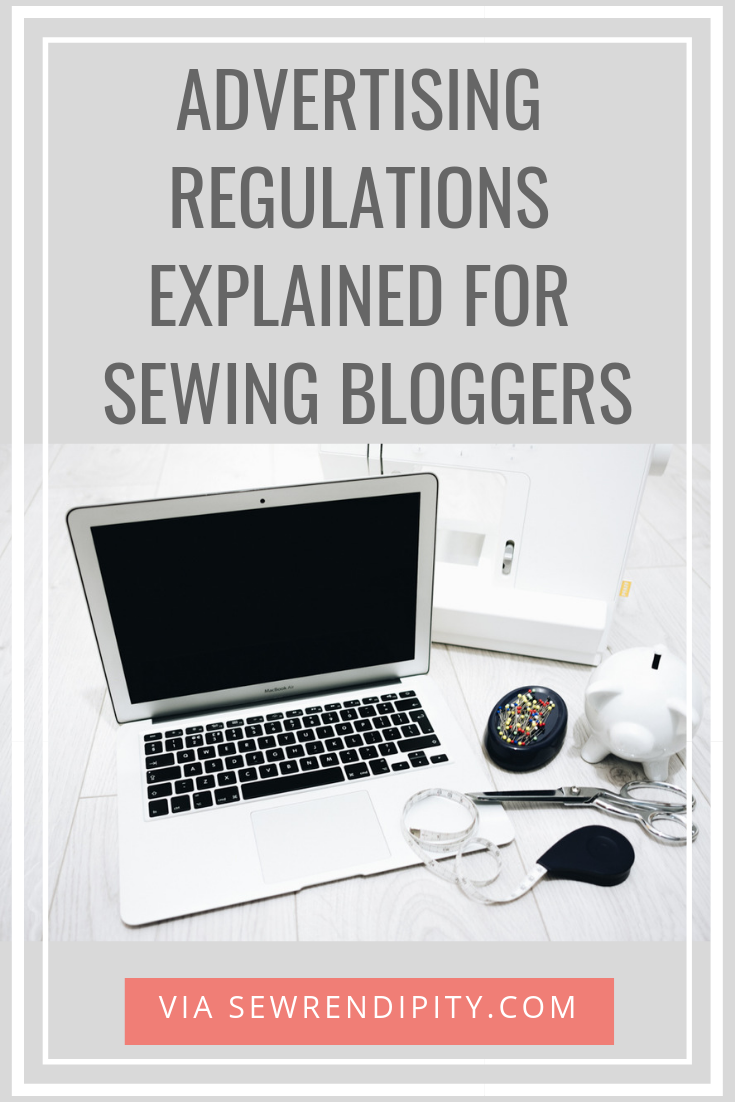
If you live in the UK, you might have noticed that there was a lot of noise in the press recently (Jan 2019), about influencers and how they need to behave in order to comply with the advertising and disclosure regulations. Celebrities with millions of followers were particularly targeted, but let’s not forget that these advertising regulations apply to any content creator(bloggers, vloggers, Instagrammers etc), including sewing ones, who promote products or services on the internet. Also, the rules also apply to brands (even if you are selling your own products, such as digital patterns, for example) and how they work with influencers, but it’s everyone’s responsibility to make sure they know what these regulations are really all about.
The regulations are out there available for everyone to access, but I wanted to reach out to the regulator, CAP, to clarify how they apply to specific sewing related scenarios, and what do we need to do in order to stay compliant.
Disclaimer: This is by no means legal advice and should not be taken as such, but my own interpretation of the ASA/CMA rules. If you want to skip straight to the source materials, scroll to the end of the post, where I link to all resources I consulted. These regulations are for UK based influencers, but they also can apply to foreign ones that are selling products/promoting brands in the UK.
I am still waiting for a reply from CAP on Affiliate links, so I will owe you one and follow-up in a future post.
WHAT ARE THE RULES?
When a brand rewards an influencer with a payment, free gift, or other perks, any resulting posts become subject to consumer protection law (CMA). When a brand also has control over the content, they become subject to the UK Advertising Code as well (ASA/CAP).
CMA RULES:
- Say when you’ve been paid, given or loaned things
- Be clear about your relationship with a brand or business
- Don’t be misleading
ASA/CAP RULES
- Make sure ads are recognisable as ads
ASA (Advertising Standards Authority) = the self-regulatory organisation of the advertising industry in the United Kingdom. The Committee of Advertising Practice (CAP) is the sister organisation of the ASA and is responsible for writing the Advertising Codes.
CMA (Competition and Markets Authority) = an independent non-ministerial department whose roles is to work to promote competition for the benefit of consumers, both within and outside the UK.

WHAT CONSTITUTES AN AD
According to ASA, there are two key factors that made an ad: PAYMENT + CONTROL. Both of them need to be met in order for the content to be considered ad and therefore to be mandatory to be marked as such (fall under ASA rules).
However, consumer protection legislation still applies where there has been ‘payment’ (i.e. any form of monetary payment, a loan of a product/service, any incentive and/or commission or the product/service has been given free) but no ‘control’ and this is enforced by the CMA.
WHAT CONSTITUTES PAYMENT
- money – pretty obvious, that one
- product – physical or digital (patterns incl. digital files, fabric, notions etc)
- services – like free printing for your patterns
- memberships – like a free Craftsy membership
- access to usually paid for events – parties or award ceremonies
- brand ambassadorship or partnership – like a blogger team for fabric stores or pattern companies ambassadors
- any other reciprocal agreement

WHAT CONSTITUTES CONTROL
If the brand demanded any form of control over what you publish, and you were not completely free to write whatever you want, whenever you want, then this condition is met.
This could be things like:
-
being asked to include:
- certain phrases, ideas, words, key messages
- hashtags
- links to websites, social media or blog posts
- images
- discount codes
- promotions
-
being required to create a particular type of content:
- product review
- unboxing
- fabric haul
- being required to post a certain number of posts or on specific types of channels
- being asked to post on a specific date, times etc
- being asked to review and approve the content or reserve the right to ask you to make changes
PAYMENT WITHOUT CONTROL
If payment has been made, but there was no control (like a TV programme), and the brand only paid for being associated with the respective content, this is not an ad. This does not fall under ASA rules.
However, the payment still needs to be disclosed as per CMA rules (see above).
HOW TO MAKE IT CLEAR THAT ADS ARE ADS
Ads must be visible and obviously identifiable as such. That means before the consumer decided to interact with the content. So a #ad in a forest of hashtags at the end of the Instagram post is not acceptable. They also have to be clear on all devices and obvious before the consumer clicks on the content (for example, an image).

The easiest way is to include a prominent label at the beginning of the content, with words such as:
- Ad
- Advert
- Advertising
- Advertisement
- Ad/Advertising/ Advertisement Feature
You should stay clear of:
- In association with
- Thanks to [brand] for making this possible
- Just @ mentioning the brand
Even if the content may not fall under ASA rules, CMA expects the same level of visibility for paid-for content (without control).
CHECK OUT THIS INFOGRAPHIC TO UNDERSTAND IF YOU NEED TO DISCLOSE:

SPECIFIC GUIDANCE FOR SEWING INFLUENCERS
I’ve emailed CAP directly to clarify various scenarios that could apply to the sewing world. Here are their answers.
1) Free patterns/ fabric – with the specific expectation to make a garment and post about it
CAP: If it is the case that the brand has supplied free patterns – irrespective of the nature of that relationship this counts as “payment” and so the first part of the “advertising” test has been met. If however the brand specifically asks/requires that use this product to make a specific garment with them and blog about it, then this is likely to be considered “editorial control” and therefore the entire blog that includes this content is likely to be considered advertising.
2) Free fabric/patterns – no conditions
CAP: If you have received free fabric and made a decision yourself to write about it and link back to the brand, this is not likely to be considered advertising (provided you can demonstrate the decision to write about the product and link to the brand was your own and not a requirement of the brand).
3) Discount codes/ promotions – if the brand offers a discount code or the link to a Rafflecopter raffle
CAP: If the brand has a promotion and you have been asked to reference it and there is also some sort of reciprocal arrangement then this combination is likely to be considered advertising. If you were to have found the offer yourself and were recommending it to your followers without influence from the brand (irrespective of payment) then the content is not likely to be considered advertising as the brand did not have editorial control over the decision to post information about the offer or how that offer was referenced.
PIN FOR LATER

3) Blog tours – when we are offered a free pattern and requested to link to pattern company and other bloggers
CAP: Whether a group of an individual, we think it likely that if there is a reciprocal arrangement and requirement to include certain information then this still counts as editorial control. Because both parts of the test have been met (payment and control) then we think the content is likely to be considered advertising.
4) Events – with the expectation to post about it, but no payment
CAP: We think it is possible that the invitation to the event from the brand itself could be considered to be a reciprocal arrangement but this is not something the ASA has considered before. However, if there is not a requirement to write something specific about the event and you free to be positive or negative about it, we think it is unlikely to be considered advertising.
5) Brand ambassadors – such as blogger networks
CAP: Content on the marketers own websites are likely to be automatically considered advertising but are unlikely to require labelling as its clear it’s advertising by its placement. Where content appears on Facebook/Twitter but the same principles apply in that, if it’s advertising then it would need to be easily identifiable as an ad.
6) Gifts – no expectations
CAP: If you are receiving free gifts and there is no obligation by the brand to talk about that gift then this is not considered advertising. It may be worth speaking to the CMA however if this would be considered sponsorship.
WHY STAYING ON THE RIGHT SIDE OF ADVERTISING REGULATIONS MATTERS

You may be wondering if all this really applies to the sewing word, as there aren’t that many influencers on the scale of the Kardashians, so we’re probably not on the hit list of ASA/CMA. I’m pretty sure the won’t be knocking on my door anytime soon (because I’m all legit, of course!).
However, through the wonderful community spirit, we all exercise influence by posting our makes, sharing opinions, commenting and liking. And I feel it’s important to be honest and transparent with the people who read/watch/follow us.
I feel that by and large, people in the community are really good at disclosing free patterns and fabric they receive and other freebies. However, what I feel we could all do better to make this more obvious, especially on social media (Instagram mainly, but Facebook and Pinterest as well) – see the section above about making ads obvious.
Secondly, the point about control is very important. Even if we all say ‘all opinions are my own’, have our editorial decisions been swayed or influenced by the brand? Were we completely free to state our opinions? If we are asked to include even the smallest detail (see above section about control), then it means we were not completely free to write however, whatever and whenever we like. I think it’s very important to make clear to our audience what strings came along with the product we are reviewing.
There is nothing wrong with accepting paid partnerships or asking for payment from brands (in money or in kind) when you are investing time and resources to create content, provided that you are being open, honest and transparent about the terms of that understanding and abiding by the regulations.
FURTHER RESOURCES ON ADVERTISING AND COMPETITION REGULATIONS
- ASA: An Influencer’s Guide to making clear that ads are ads
- CMA: Social media endorsements: being transparent with your followers
- IAB UK: Do I need to disclose infographic
- ASA guidance on Affiliate Marketing
- Blogtacular Podcast with Emma Smith from ASA/CAP
- Catherine from Not Dressed as Lamb on how to signpost ad content for blogs and social media
- My Reader Disclosure Policy
WHAT DO YOU THINK ABOUT THE RULES ABOVE IN RELATION TO THE SEWING COMMUNITY? OVERKILL OR COMMON SENSE? DO YOU FEEL THAT INFLUENCERS IN THE SEWING COMMUNITY ARE BROADLY FOLLOWING THE RULES? OR CAN WE DO BETTER? WOULD LOVE YOUR THOUGHTS, SO PLEASE LEAVE ME A COMMENT.
ENJOYED THIS POST?


I think the process of setting out the “rules of engagement” re influencers – bloggers & vloggers has been very enlightening for everyone. I think it’s redundant to say, “The pattern was provided but all opinions are my own.” Who else’s opinion would it be? I think some bloggers say glowing remarks about all the patterns they review are wonderful (to be fair maybe they always use those patterns because they happen to consistently like them for any number of reasons) and most of their readership knows to expect that from their postings. It always seems to me that sewists who are bloggers/vloggers are meticulous in their sponsorship disclosures 🙂 To be honest I’ve always felt that a free pattern hardly pays for a full blog posting of any sort 🙂 … just sayin…
Author
For me, writing a useful post is the most important thing, whether I got the pattern for free or it’s from my deep stash. Also, I won’t accept a pattern I don’t like or it’s not my style even if I get it for free. And I always stipulate that I can write whatever I want in the review, my true opinions. If people are not happy with that, then clearly that collaboration is not for me.
And you are absolutely right, even expensive patterns are not worth the fabric, plus labour to make them, not to mention the time to take pictures, edit and write the post.
I too think it is very enlightening and thank you for explaining the legalities. I’ll print it off and will remind the bloggers/vloggers on YouTube of it, I watch that channel quite a lot, so many of them pronounce their designer buys/opinions with no mention of being sponsored or getting payment for their comments. I visit FB too but have locked down heavily on who can go there or if I find their input is more like an advert then the same will apply. Alex, so far you are the only sewing person I accept things from and thank you again for the clarity. I am not employed or sponsored by any company and merely have a personal interest and opinion in anything to do with sewing and embroidery.
Author
Thank you for commenting, Elaine! I think it’s important that readers also know what we as bloggers should be doing, so that they can keep us accountable. ASA will not come to call out a blogger with under 10k followers, that’s too small potatoes. But our readers might, if they know what rules we are meant to be following.